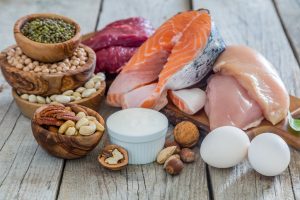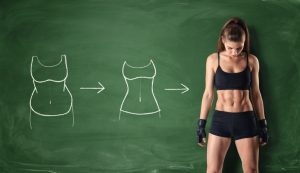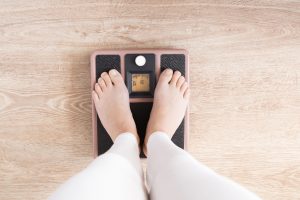In this post, we will go through a ‘step by step’ of how to reverse diet properly. You’ll learn the right way to increase your calories, and what to eat for your own goals. You’ll also find out when to stop reverse dieting. Before we dive in, it’s essential that you know if reverse dieting is right for you – it’s not one size fits all! So if you haven’t done so already, read my previous post. This explains how reverse dieting works and whether it’s right for you.
How to Reverse Diet Properly
The quick answer to how to reverse diet properly? Undergo gradual, controlled increases in your calorie intake. But the right amount of calories differs from person to person.
Through reverse dieting, you slowly train the metabolism to adapt to more food. But not all foods are equal. Different quantities of macro-nutrients will suit different goals. It’s therefore recommended to work out your own personal macronutrient goals. It’s also useful to know how to increase them in the right quantities for you.
These steps cover how to find this information and tailor your reverse diet to your goals. Then you can begin, confident that you know how to reverse diet properly.
So, let’s get started!
How To Reverse Diet Properly: Training
Before we start number crunching, let’s first touch on training. Certain adjustments to your workouts coincide with how to reverse diet properly.
As your calorie intake goes up, it’s a great time to start a new weight training program. Use your added calories to sculpt your figure, and enjoy the new strength that comes with more energy!

Heavy resistance training has benefits on the metabolism short term, and on the long haul. Short-term benefits include revving up the metabolism post-workout. Resistance training also builds muscle. This increases your metabolic rate in the long term.
If you’re a cardio fan, you might need to ‘taper off’ if you want the best from your reverse diet. As you increase your energy intake, decrease the frequency of cardio sessions.
Now you know the right type of training to help you reverse diet properly, let’s move on to calories and macros.
How to Reverse Diet Properly: Step by Step
The following step by step guide on how to reverse diet properly can seem a little daunting. It involves a bit of mental effort to first work out some key figures. But you only need to do these steps once! Once you have this information, you’re ready to reverse that diet.
1. Establish Baseline Calorie Intake
To reverse diet properly, you need to know your baseline intake. Big jumps in your calorie intake can shock your body, not giving it a chance to adapt. This can result in fat gain. Similarly, too little change won’t allow your body to learn. We need to first work out how many calories you’re currently consuming, so we know what we’re adding on top.
If you’re on a calorie controlled diet, you might already be well aware of your daily intake. If not, grab yourself a simple food weighing scale. Then, download a calorie tracking app. I recommend MyFitnessPal. This app makes it easy for you to also track your macros, which will help later on in the process.

As you go about your day, track your food. After a few days, you’ll have a good idea of your average current daily calorie intake. This is your baseline calorie intake. When I started, mine was 1800 calories. We will use this figure as an example throughout the rest of these steps.
2: Work Out Your Macronutrient Goals
Part of how to reverse diet properly is gaining an understanding of macronutrients. Getting the right macronutrient balance for your goal gives the best results.
Protein
Proteins consist of essential amino acids. They’re called ‘essential’ because you cannot make them yourself. So you need to get enough protein in your diet! This does not just apply to those wanting to build muscle. Protein provides the ‘building blocks’ of the body and is key to restoring your body to health.
On the flip side, it is possible to get too much protein. The average person needs around 0.8g of protein per kilogram of body weight. Even professional athletes have an upper limit of usable protein (Hoffman et al., 2006).

So, how much protein do you really need? If you want to know how to reverse diet properly, you should work out your calorie target for protein goal. The number of grams of protein you need a day depends on your body weight and your level of activity. It also depends on whether you’re pregnant:
- Not very active (sedentary job, light exercise): 0.8kg per kilogram
- Active (training regularly, active lifestyle) or pregnant: 1.3g per kilogram
- Extremely active (athletes and sports people): 1.4g per kg for endurance athletes, 1.7g per kg for strength and power athletes (Institute of Medicine of the National Academies, 1997)
How to Calculate Protein Goal
To work out your protein goal in grams, take your body weight in kilograms, and decide on which recommended protein intake above best fits your lifestyle. Multiply these together to get your baseline protein goal in grams.
My bodyweight is around 58kg, and I train in the gym regularly, so I decide I need 1.3g per kilogram of bodyweight:
58 * 1.3 = 75.4g
I need on average 75g of protein per day. What does this look like in calories? Protein has 4 calories per gram. So, to then get your calorie goal for protein, multiply the protein goal you worked out above, by 4:
75 * 4 = 300 calories
I found I needed to be consuming around 300 calories of protein per day. Now you have your protein goal, make sure you’re hitting this daily. If you’re not currently getting enough, this should be the first thing to ensure you change. So what do we do with the remaining calories? This is where carbohydrates and fats come in.
Carbohydrate and Fat
Fat and carbohydrate will make up the rest of your calories. My baseline calorie intake was 1800 calories. My protein goal (calculated in step 2) was 300 calories. I subtract my protein goal from my baseline calories, to get the remainder:
1,800 – 300 = 1,500 calories remaining
There is no hard and fast rule around how these calories should be split into fat and carbohydrate. Dietician Katie Coles, MS, RD recommends a 60/40 split between carbohydrate and fat, and the choice on how to split it is entirely yours.

However, when it comes to how to reverse diet properly, you should get the right balance depending on your goal. We will now discuss the role of each macronutrient group about your goals. This will help you to take a more tactical approach when allocating your remaining baseline calories.
Carbohydrates
Are you reverse dieting to see muscle gain or improve performance during training? Then you might want to allocate most of your remaining calories to carbohydrate. Carbohydrate is the body’s preferred energy source for intense exercise. Higher carbohydrate intake will improve your workout performance (http://www.ncbi.nlm.nih.gov/pubmed/10365988). It also minimises muscle breakdown when you exercise.
Fats
Prefer lower intensity exercise? Then you might prefer to allocate a greater portion of your remaining calories to fat. During more prolonged periods of lower intensity training, fats are a significant energy contributor. Fat contributes up to 60% of the energy expenditure during low-intensity exercise (Askew, 1984).
Fat is also denser in calories per gram. So if you’d struggle with eating enough extra food, opting for a higher percentage of fat might be best for you. It will help you to ensure you get enough calories in if you have a busy lifestyle or don’t want to feel too full.
3. Allocating Remaining Calories
Now you’re armed with the right knowledge on macronutrients. Time to take our next step in how to reverse diet properly.
You should have now decided what macronutrient is best for you at higher levels. Regardless of your goal, cutting out one food group entirely is not recommended. An imbalanced macronutrient intake does not constitute how to reverse diet properly. This can damage your hormone balance and metabolism. Healing these systems is how to reverse diet works. So you want to aim for a fairly even split between carbohydrate and fat.
Establishing Goals for Carbohydrate and Fat
I went with the advice of dietician Katie Coles and split my remaining calories 60/40. My remaining calories after subtracting my protein target (step 2) from my baseline intake (step 1) was 1500 calories. To get 60% and 40% respectively, I do the following calculations:
1,500 * 0.6 = 900 calories 1,500 * 0.4 = 360 calories
I had been on low carbohydrate diet for a long time when I began reverse dieting. My main aim was to get back the energy for training, and muscle mass I’d lost. So, I decided that the larger portion of my remaining calories (60%, or 900 calories) would come from carbohydrate. The smaller portion (40%, 360 calories) would come from fat.
It’s useful to know your carbohydrate and fat goals in grams. Using MyFitnessPal, this is how you’ll likely be tracking your food. Carbohydrate has 4 calories per gram, and fat has 9. To get my goals for carbohydrate and fat I did the following calculations:
Carbohydrate: 900 / 4 = 225g
Fat: 360 / 9 = 40g
I needed to aim for 225g of carbohydrate, and 40g of fat per day as a baseline. While your protein goal stays constant, increases in calories will come from carbohydrate and fat. You can change these percentages throughout. This depends on what you feel is working well for you. We’ll cover how to keep an eye on this in the next steps on how to reverse diet properly.
4. Start Increasing
Now, you should have your baseline calories (step 1), and your macronutrient targets (steps 2 and 3). Breathe a sigh of relief – you can finally put down your calculators! It’s time to begin planning your increase in calories.
To determine how to reverse diet properly, you’ll want to decide how quickly to increase. This is different depending on your goals. Is your primary focus to gain muscle mass or performance? More significant increases lead to faster gains. This means a speedier reverse might be right for you.

This approach also benefits those struggling with binge eating or cravings. Dietician Katie Coles recommends that you increase in line with your calorie targets by 6-10% per week. She also suggests to give yourself a jump start, you might want to boost your increase in the first week. This can be up to 15%.
A slower increase is better if you’re concerned with gaining fat. This approach is best if you want to taper off a restrictive diet, without putting the weight all back on. How to reverse diet properly for this goal? Just reduce the amount you increase by. Coles recommends a conservative increase of 2-5% per week.
5. Measurement and Tracking
If you want to learn how to reverse diet properly for your individual body, you want to track what you’re eating. You also need to keep an eye on your progress. You can then make informed adjustments to your reverse diet.
Tracking Food Intake
A food weighing scale is essential if you’re not used to tracking the macros and calories in the food you eat. This coupled with MyFitnessPal app allows you to easily ensure you’re hitting your targets. I’m wary of measuring food to the exact gram for too long, as it can get obsessive. After a while, you’ll learn a bit more about what’s in your food and how much to eat. I recommend you taper off the precise weighing. Go by eye to after you feel confident in your knowledge of what’s in your food.
Tracking Physical Changes
Your bodyweight will increase slightly as you increase your calorie intake, and then ‘level out’ as it adjusts. Weighing yourself regularly is one way of ensuring this is happening correctly. However, doing this too often can also get obsessive. Plus, weight fluctuations can be caused by many other things. Water retention, where you are in your menstrual cycle, or even when you last went to the bathroom can have an effect.

This is why I recommend you also track your progress visually. If you’re training while you’re reverse dieting, a couple of pounds on the scale isn’t necessarily body fat. Muscle weighs more than fat, and this can look great on your physique.
When To Stop Reverse Dieting
We’ve now covered how to reverse diet properly. But when should you stop?
If you’re reversing to taper off a restrictive diet, or because you were sick of trying to maintain a low weight on ridiculously minimal calories, stop when you’re happy with your food intake and weight.
If your primary goal was to improve athletic performance or muscle gain, you can keep on increasing. This is true also for those who are looking to kickstart the metabolism after a weight loss plateau. But there’ll come the point on your reverse diet when your metabolism stops adapting to extra calories. The telltale sign of this is that you begin to gain weight linearly. You might also see a plateau in athletic performance or muscle gain.
Tapering Down Gradually and TDEE
This is the point at which you stop reverse dieting. Tapering back down should be as gradual a process. Just like you measured your calorie increases, you should gradually decrease.
Do this until you hit your total daily energy expenditure (TDEE). This thankfully does not require any more mathematics on your part! You can work out your TDEE using this online tool. Then, you’re ready to move onto your next goal.
Summary
As you’ve learned, when it comes to how to reverse diet properly, there’s no one size fits all approach. Each person is different when it comes to calorie and macronutrient requirements. You should now be equipped with the knowledge you need to tailor your reverse diet to your specific goals. The reverse diet, when done properly, is an opportunity to both heal and learn about your body and what suits it best. Now you know how to reverse diet properly, happy reversing!
